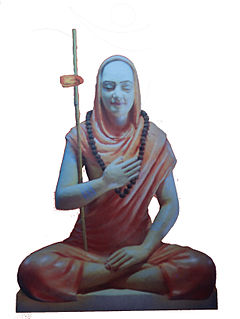In Sanskrit texts, Rāja yoga was both the goal of yoga and a method of attaining it. The term also became a modern name for the practice of yoga, when in the 19th-century Swami Vivekananda equated raja yoga with the Yoga Sutras of Patanjali. Since then, Rāja yoga has variously been called "royal yoga", "royal union", "sahaj marg", "classical yoga", and "aṣṭāṅga yoga".
The Ashtavakra Gita or the Song of Ashtavakra is a classical Advaita Vedanta scripture. It is written as a dialogue between the sage Astavakra and Janak, king of Mithila.

Kashmir Shaivism is a group of nondualist Tantric Shaiva exegetical traditions from Kashmir that originated after 850 CE. The term Trika was used by Abhinavagupta to represent the entire Kashmir Shaivism or to designate the Pratyabhijna system and this was actually pan-Indian, also flourishing in Oḍiśā and Mahārāṣṭra.

The Isha Upanishad is one of the shortest Upanishads, embedded as the final chapter (adhyāya) of the Shukla Yajurveda. It is a Mukhya Upanishad, and is known in two recensions, called Kanva (VSK) and Madhyandina (VSM). The Upanishad is a brief poem, consisting of 17 or 18 verses, depending on the recension.

The Māṇḍūkya Upaniṣad is the shortest of all the Upanishads, and is assigned to Atharvaveda. It is listed as number 6 in the Muktikā canon of 108 Upanishads.

Gauḍapāda c.6th century CE), also referred as Gauḍapādācārya, was an early medieval era Hindu philosopher and scholar of the Vedanta school of Hindu philosophy. While details of his biography are uncertain, his ideas inspired others such as Adi Shankara who called him a Paramaguru.

The Vivekachudamani is an introductory treatise within the Advaita Vedanta tradition of Hinduism. It is in the form of a poem in the Shardula Vikridita metre, and for many centuries has been celebrated as a prakaraṇa grantha of Advaita. The Hindu tradition attributes it to Adi Shankara of the eighth century CE. This attribution is controversial, generally considered "most probably erroneous" by modern scholarship. Its likely author may be one of the other Shankaracharyas of the Advaita tradition.
The Narada Bhakti Sutra is a well known sutra venerated within the traditions of Hinduism, reportedly spoken by the famous sage, Narada. The text details the process of devotion (Bhakti), or Bhakti yoga and is thus of particular importance to many of the Bhakti movements within Hinduism. It has received particular attention among the Vaishnava traditions.
Adi Shankara, a Hindu philosopher of the Advaita Vedanta school, wrote a large body of works which are central to the Advaita Vedanta interpretation of the Prasthanatrayi, the canonical texts consisting of the Upanishads, the Bhagavad Gita and the Brahma Sutras. His works deal with logically establishing the doctrine of Advaita Vedanta.
The Shanti Mantras or "Peace Mantras" or Pancha Shanti are Hindu prayers for Peace (Shanti) found in Upanishads. Generally they are recited at the beginning and end of religious rituals and discourses.

Self-enquiry, also spelled self-inquiry, is the constant attention to the inner awareness of "I" or "I am" recommended by Ramana Maharshi as the most efficient and direct way of discovering the unreality of the "I"-thought.

Nome is a spiritual teacher at Society of Abidance in Truth, known by the acronym SAT, which established and maintains a temple for nondual Self-knowledge in California. He expounds the teachings of Sri Ramana Maharshi and Advaita Vedanta. He, along with Dr. H. Ramamoorthy, translated into English the essential and classic work of Advaita Vedanta, "Ribhu Gita", which was highly recommended by Sri Ramana Maharshi. The English translation has been published by Society of Abidance in Truth and has since then been re-published by Sri Ramanasramam and translated into Hindi, Italian, Korean, and German.

The Bhagavad Gita, often referred to as the Gita, is a 700-verse Sanskrit scripture that is part of the Hindu epic Mahabharata.

Enlightenment is the "full comprehension of a situation". The term is commonly used to denote the Age of Enlightenment, but is also used in Western cultures in a religious context. It translates several Buddhist terms and concepts, most notably bodhi, kensho and satori. Related terms from Asian religions are moksha (liberation) in Hinduism, Kevala Jnana in Jainism, and ushta in Zoroastrianism.
The Vijñāna Bhairava Tantra is a key Tantra text of the Trika school of Pratyabhijna/Kashmir Shaivism in Sanskrit language. Cast as a discourse between the god Bhairava and his consort Bhairavi, it briefly presents 112 Tantric meditation methods or centering techniques (dharana). These include several variants of breath awareness, concentration on various centers in the body, non-dual awareness, Mantra chanting, imagination and visualization and contemplation through each of the senses. A prerequisite to success in any of the 112 practices is a clear understanding of which method is most suitable to the practitioner.

Vedantasara, Essence of Vedanta, is a 15th-century Advaita vedanta text written by Sadananda Yogendra Saraswati.
Panchadasi or Panchadashi is a simple yet comprehensive manual of Advaita Vedanta written in the fourteenth century A.D (1386-1391) by Vidyaranya (विद्यारण्य), previously known as Madhavacharya (माधवाचार्य).
Uparati, is a Sanskrit word and it literally means "cessation, quietism, stopping worldly action". It is an important concept in Advaita Vedanta pursuit of moksha and refers to the ability to achieve "dispassion", and "discontinuation of religious ceremonies".
In Hindu thought, Anubhava or anubhavah refers to personal knowledge or aesthetic experience.

Ātma-bodha is a short Sanskrit text attributed to Adi Shankara of Advaita Vedanta school of Hindu philosophy. The text in sixty-eight verses describes the path to Self-knowledge or the awareness of Atman.










